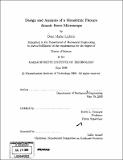| dc.contributor.advisor | David L. Trumper. | en_US |
| dc.contributor.author | Ljubicic, Dean M | en_US |
| dc.contributor.other | Massachusetts Institute of Technology. Dept. of Mechanical Engineering. | en_US |
| dc.date.accessioned | 2009-04-29T17:07:13Z | |
| dc.date.available | 2009-04-29T17:07:13Z | |
| dc.date.copyright | 2008 | en_US |
| dc.date.issued | 2008 | en_US |
| dc.identifier.uri | http://hdl.handle.net/1721.1/45201 | |
| dc.description | Thesis (S.M.)--Massachusetts Institute of Technology, Dept. of Mechanical Engineering, 2008. | en_US |
| dc.description | Includes bibliographical references (p. 175-178). | en_US |
| dc.description.abstract | This thesis details the design, manufacture, and testing of a sub-nanometer accuracy atomic force microscope. It was made to be integrated into the Sub-Atomic Measuring Machine (SAMM) in collaboration with the University of North Carolina at Charlotte (UNCC). The microscope uses a tuning fork sensor to gauge its proximity to the sample surface. The sensor is fixed to a stage that is guided to move in one degree of freedom by a monolithic flexure. A piezoelectric actuator drives the moving stage while three capacitance sensors provide a non-contact direct measurement of the displacement. A decoupling flexure prohibits the error motions of the actuator from propagating into the moving stage. A digital control system uses closed loop control to regulate the vertical displacement of the stage. The positioning system demonstrated a 450 Hz -3db closed loop bandwidth and 0.249 RMS noise positioning. A new probe named after its inventor Dr. Terunobu Akiyama is implemented in a feedback control system that adjusts the displacement of the stage in order to maintain a constant gap between the probe and the sample. The system displayed an 8.3 nm RMS positioning noise when set to measure a stationary block of aluminum. The dynamics of the feedback control loop indicate that the system can operate at 27 Hz upon application of a proportional controller. Advanced methods to self excite the tuning fork sensor at resonance by use of a phase locked loop are explored. Follow-up work to integrate the atomic force microscope into the SAMM stage, diminish the electrical noise in the tuning fork, and to implement the phase locked loop circuit are suggested. | en_US |
| dc.description.statementofresponsibility | by Dean Marko Ljubicic. | en_US |
| dc.format.extent | 178 p. | en_US |
| dc.language.iso | eng | en_US |
| dc.publisher | Massachusetts Institute of Technology | en_US |
| dc.rights | M.I.T. theses are protected by
copyright. They may be viewed from this source for any purpose, but
reproduction or distribution in any format is prohibited without written
permission. See provided URL for inquiries about permission. | en_US |
| dc.rights.uri | http://dspace.mit.edu/handle/1721.1/7582 | en_US |
| dc.subject | Mechanical Engineering. | en_US |
| dc.title | Design and analysis of a monolithic flexure atomic force microscope | en_US |
| dc.type | Thesis | en_US |
| dc.description.degree | S.M. | en_US |
| dc.contributor.department | Massachusetts Institute of Technology. Department of Mechanical Engineering | |
| dc.identifier.oclc | 301733007 | en_US |
